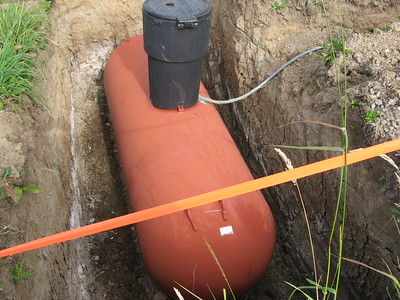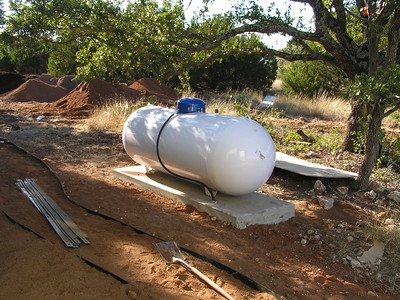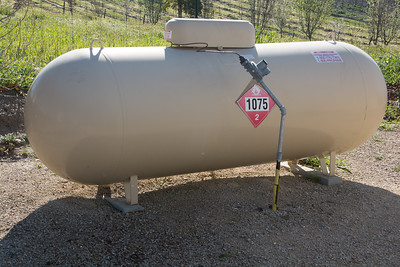
Propane has long been recognized as a cost-effective and reliable source of energy for homes and businesses alike. One popular option for storage is the 500-gallon underground propane tank.
Known for their durability, safety, and aesthetic appeal, these tanks provide a superb solution for large-scale propane users seeking a long-term fuel storage solution.
In this article, we delve into the specifics of 500-gallon underground propane tanks, exploring their advantages, installation process, maintenance requirements, and more.
Whether you’re a homeowner seeking an unobtrusive energy solution, or a business owner looking to understand the benefits of large-capacity underground propane storage, this comprehensive guide will provide you with the key insights you need.
So, let’s uncover the reasons why 500-gallon underground propane tanks are becoming a preferred choice for many.
Read this article: Are Underground Propane Tanks Regulated?
Is This Size Right for Your Home
Determining whether a 500-gallon propane tank is the right size for your home depends on several factors:
- Your Propane Usage: This is the most critical factor. Consider all the appliances in your home that use propane. This can include furnaces, water heaters, stoves, clothes dryers, fireplaces, and outdoor grills. A home with numerous propane appliances or high energy usage might require a 500-gallon tank, while a home with fewer propane appliances may need a smaller size.
- Size of Your Home: The size of your home can also play a role. Larger homes often require more energy for heating, so a larger propane tank might be necessary.
- Frequency of Delivery: Larger tanks require fewer fill-ups, which can be advantageous, especially during winter months when propane demand is high.
- Climate: If you live in a colder climate where you’ll be using propane for home heating regularly, a larger tank may be a good fit.
- Backup Energy Needs: If you use propane for a backup generator, it’s important to have enough fuel to sustain your home during an outage. Larger tanks can provide a longer running time for your generator.
- Budget and Space: Larger tanks cost more initially and require more space. Ensure your budget and the available space can accommodate a 500-gallon tank.
If your usage is high or you prefer the convenience of fewer deliveries throughout the year, a 500-gallon propane tank could be a good fit. However, if your propane usage is relatively low, a smaller tank may suffice. It’s best to consult with a propane supplier or a professional to help evaluate your needs and choose the right size tank for your home.
Read this article: Are Underground Propane Tanks Safer Than Above Ground?
The 500-Gallon Propane Tank Description
A. Description and Specifications of the 500-Gallon Propane Tank
The 500-gallon propane tank is a sizable, sturdy piece of equipment designed to safely store propane for residential, commercial, or agricultural use. Typically, this type of tank is made from heavy-duty steel and measures around 9.5 feet in length and 4 feet in diameter, although dimensions can vary slightly depending on the manufacturer. A protective coating is often applied to resist corrosion, particularly important for underground tanks. It is also equipped with safety valves and regulators to manage the propane pressure and prevent overfilling.
Read this: Will You Buy Refurbished or Reconditioned Propane Tanks?
B. Ideal Usage Scenarios for the 500-Gallon Size
The 500-gallon propane tank is an excellent choice for moderate to large-scale propane users. For residential use, it is often chosen by homeowners with larger properties or those who rely heavily on propane for heating, cooking, water heating, and perhaps even for a backup generator. For commercial use, it can supply propane for a variety of purposes, such as heating large spaces, fueling kitchen appliances in restaurants, or powering machinery in different industries. In agricultural settings, a 500-gallon tank can support crop drying, irrigation, and heating farm buildings.
C. Comparisons with Other Tank Sizes in Terms of Capacity and Usage
Propane tanks come in a variety of sizes to cater to different usage requirements. Smaller tanks, such as the 120-gallon or 250-gallon variants, are ideal for smaller homes or businesses with minimal propane needs. These tanks are often used for specific applications like cooking or water heating.
The 500-gallon tank, on the other hand, offers a more versatile solution, capable of servicing multiple appliances simultaneously or providing heat for larger homes. It bridges the gap between smaller residential tanks and the considerably larger 1,000-gallon tanks, which are often used for very large residences, commercial properties, or high-demand industrial applications.
The 500-gallon propane tank offers a balanced blend of capacity and versatility, making it a popular choice for a broad range of users. As always, the right tank size for you will depend on your specific propane needs, local regulations, and the space available for tank installation.
Advantages of an Underground Propane Tank
Underground propane tanks offer several distinct advantages over their above-ground counterparts. The following are some of the key benefits:
- Aesthetic Benefits: One of the primary reasons homeowners choose underground propane tanks is to maintain the visual appeal of their property. Since these tanks are installed underground, they don’t interfere with landscaping or architectural designs. This makes them an ideal choice for homeowners who don’t want their property aesthetics compromised by the presence of a large, visible propane tank.
- Safety Benefits: Underground propane tanks also have certain safety advantages. They are protected from the weather, reducing the risk of damage from severe conditions such as high winds, hail, or extreme heat. This makes them less vulnerable to leaks, which can be hazardous. Additionally, because they are hidden from view, they are less likely to be damaged by accidents or vandalism, reducing the risk of potential propane leaks or explosions.
- Longevity: Underground propane tanks are typically built to last longer than above-ground tanks. They are often constructed with heavier steel and are coated with a special material that protects them from corrosion. The soil in which the tank is buried also provides a natural form of insulation, protecting the tank from extreme temperature fluctuations, which can reduce its lifespan. As a result, with proper maintenance, underground propane tanks can serve a property for several decades, making them a cost-effective long-term solution for propane storage.
Overall, the choice between an above-ground and underground propane tank will depend on a variety of factors, including individual needs, budget, and property characteristics. However, the aesthetic, safety, and longevity advantages offered by underground tanks make them a compelling choice for many homeowners and businesses.
Cost Considerations
A. Initial Costs of a 500-Gallon Underground Propane Tank
The initial cost of a 500-gallon underground propane tank can vary significantly based on factors such as the manufacturer, the specific features of the tank, and the region where you live. On average, the cost can range from $1,500 to $3,000 for the tank alone. It’s important to remember that buying a tank is a long-term investment, and quality should not be compromised to save on upfront costs.
Read this article: How to Buy a Propane Tank Under Financing Terms?
B. Installation Costs
The cost of installing a 500-gallon underground propane tank will depend on several variables. These include the complexity of the installation (e.g., how much excavation is required), local permit requirements, and whether any additional equipment or materials are needed. Typically, installation costs can range from $500 to $2,000. Hiring a certified professional for the installation is crucial to ensure safety and compliance with local regulations.
C. Maintenance and Long-Term Costs
Long-term costs associated with a 500-gallon underground propane tank primarily involve routine maintenance and propane refills. Maintenance costs are generally minimal and might include periodic inspection services and potential component replacements over the lifespan of the tank. The cost of propane varies based on market conditions and regional factors but expect to budget for regular refills, especially during the high-demand winter months.
D. Cost-Benefit Analysis
While the initial investment in a 500-gallon underground propane tank might seem high, it’s important to consider the benefits and potential savings over time. Given their longevity, underground tanks often prove to be cost-effective in the long run. They can last for decades, meaning the initial cost is spread out over many years of use. Additionally, owning your own tank gives you the flexibility to shop around for propane at the best price, which can lead to significant savings.
Furthermore, having a large capacity tank ensures you can stock up on propane when prices are lower and use it during higher-demand periods. The added benefits of improved property aesthetics and potential property value increase also contribute to the overall cost-effectiveness of this choice.
While investing in a 500-gallon underground propane tank involves significant upfront costs, the long-term benefits often outweigh the initial expenditure, making it a financially sound decision for many homeowners and businesses.
The Process of Installing a 500-Gallon Underground Propane Tank
A. Detailed Step-by-Step Guide to Installation
- Site Selection: Choose a location for the tank that’s easily accessible for propane deliveries but also away from potential hazards and complies with local laws.
- Site Preparation: Clear the selected area of any debris or obstacles. Excavation is then performed, with the hole being slightly larger than the size of the tank.
- Tank Placement: Using special equipment, the tank is carefully lowered into the prepared hole.
- Backfilling: The tank is backfilled with material that will not damage the outer coating, usually a combination of sand and soil.
- Piping: Propane lines are then run from the tank to the house or commercial building.
- Testing: The entire system, including the tank and all connections, is then pressure tested to ensure there are no leaks.
- Initial Fill: The tank is filled with propane to a safe level, and the system is checked for proper operation.
B. Consideration of Local Laws and Regulations
Before installing a 500-gallon underground propane tank, it’s crucial to understand and follow local laws and regulations. These regulations may dictate how far the tank must be placed from structures, property lines, and sources of ignition. Permits may be required for the installation, and inspections might be mandated. Always consult with a local propane professional or your municipal office to understand these requirements.
C. Pre-Installation Preparations: Site Assessment and Choosing a Location
The site for your propane tank should be chosen carefully. It should be in a location that’s easily accessible for propane deliveries, away from high-traffic areas, and a safe distance from any structures or property lines. The site should also be level and able to support the weight of a filled propane tank. Professional site assessments can help determine the best location for your propane tank.
D. Post-Installation Processes: Safety Inspections and Maintenance
Once the tank is installed, it’s essential to have regular safety inspections and maintenance to ensure the system continues to operate safely and efficiently. This typically involves regular checks for leaks, inspections of valves and regulators, monitoring propane levels, and checking the overall condition of the tank. A maintenance schedule should be established with a local propane professional.
In conclusion, installing a 500-gallon underground propane tank is a considerable project that involves careful planning, adherence to local regulations, and ongoing maintenance. With a professional approach, this process can provide a reliable and efficient propane system for many years to come.
Maintenance and Safety of Underground Propane Tanks
A. Routine Maintenance Needs
Regular maintenance of a 500-gallon underground propane tank is essential for its longevity and safety. Some of the routine tasks include:
- Regular visual inspection: Although the tank is underground, external components like the dome, valves, and regulators should be regularly checked for visible signs of damage or corrosion.
- Checking for leaks: A professional should periodically check the tank for possible leaks, especially around the valves and fittings.
- Assessing propane levels: It’s crucial to monitor propane levels regularly to avoid running out of gas and to ensure that the tank is not overfilled.
- Clearing the tank dome: Debris, snow, or soil should be cleared from the dome area to prevent obstruction of the tank’s components.
B. Safety Inspection Procedures
Safety inspections should be conducted by a certified propane technician. They will perform a thorough examination of the tank, checking for any signs of wear, leaks, or damage. This includes checking the pressure relief valve, liquid level gauge, and all connections for potential issues. Many professionals recommend annual safety inspections, though the frequency may vary based on local regulations and the age and condition of your tank.
C. Identifying and Addressing Potential Issues
Some common issues that may arise with underground propane tanks include:
- Corrosion: Although these tanks are designed to resist corrosion, it can still occur. Regular inspections can help identify early signs of corrosion.
- Leaks: Even small leaks can be dangerous. Signs of a leak can include a strong smell of gas, hissing sounds, or dead vegetation around the tank area.
- Overfilling: Overfilling a tank can lead to increased pressure and potential damage. Propane deliveries should always be monitored to avoid overfilling.
- Inadequate propane levels: If a tank runs completely out of propane, it will need a safety check and potentially a leak test before it can be refilled.
Problems like these should be addressed promptly to avoid hazards. If you suspect an issue with your underground propane tank, it is important to contact a professional immediately. By maintaining a routine inspection schedule and taking swift action to address potential issues, you can ensure that your 500-gallon underground propane tank remains a safe and reliable source of energy.
How Big is a 500 Gallon Underground Propane Tank?
A 500-gallon underground propane tank typically measures around 9.5 feet in length and approximately 4 feet in diameter. However, these dimensions can slightly vary depending on the manufacturer.
Although the majority of the tank is buried underground, a small dome usually sticks up above the surface to provide access for filling, maintenance, and gauge reading. The size of the dome can vary, but it’s typically around 1.5 feet in height.
Remember, it’s not just the size of the tank that’s important for installation, but also the extra space needed for installation and access for maintenance and propane delivery. Always ensure you consult with a professional to assess the best location and process for installing an underground propane tank on your property.
Underground Vs Above Ground Propane Tank
| Aspect | Underground Propane Tank | Above-Ground Propane Tank |
|---|---|---|
| Installation | Buried underground | Positioned above ground |
| Visual Appeal | Minimal visual impact | Visible and may impact aesthetics |
| Protection | Sheltered from weather conditions | Exposed to weather conditions |
| Safety | Reduced risk of accidents or damage | Potential for accidents or damage due to external factors |
| Longevity | Typically longer lifespan due to protection from elements | Prone to deterioration from weather and corrosion |
| Maintenance | Periodic inspections and maintenance required | Easier access for inspections and maintenance |
| Capacity Options | Various sizes available, including 500-gallon capacity | Wide range of sizes available |
| Cost | Higher initial cost due to excavation and installation process | Lower initial cost |
| Property Considerations | Requires space for excavation and underground placement | Requires space above ground and may impact landscaping |
| Regulatory Considerations | Compliance with local regulations for underground tank installation | Compliance with local regulations for above-ground tank placement |
| Refilling | Requires access for propane delivery trucks | Easily accessible for propane delivery trucks |
It’s important to note that the suitability of an underground or above-ground propane tank depends on individual needs, local regulations, and property characteristics. Consulting with a propane professional can help you determine the best option for your specific requirements.
In Conclusion
The choice to invest in a 500-gallon underground propane tank is one that combines practicality with foresight. Offering a balance of size, capacity, and longevity, this tank size is a popular choice for homeowners and businesses alike.
With significant benefits, including preserving your property’s aesthetic appeal, providing safety advantages, and promising a long lifespan, this type of propane storage solution could be a crucial component in your quest for reliable, cost-effective energy. However, it’s essential to factor in your specific propane usage, local regulations, and the space available for tank installation before making your final decision.
While the initial cost of buying and installing a 500-gallon underground propane tank may seem high, the long-term advantages and potential savings make it a worthy consideration. With the appropriate routine maintenance and safety checks, your underground propane tank can provide decades of dependable service.
This guide aimed to shed light on all aspects of the 500-gallon underground propane tank – from its installation process and maintenance requirements to cost considerations. Whether you’re a homeowner seeking a powerful, efficient, and unobtrusive energy solution, or a business owner looking to understand the benefits of large-capacity underground propane storage, we trust that this comprehensive guide has provided you with the key insights you need.
Remember, your choice of propane tank is not merely about meeting your present needs; it’s about planning for your energy future. So, explore the benefits of a 500-gallon underground propane tank and power your home or business with confidence and peace of mind.

Mike is an experienced propane technician with over 15 years of professional experience in the field. He has dedicated his career to helping customers with their propane needs, from installation to maintenance and repair. Together with Jeremy, he co-founded this website to provide useful information and guidance to customers seeking reliable propane services.



